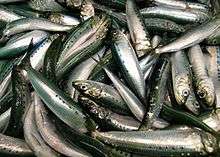South American pilchard
| South American pilchard | |
|---|---|
 | |
| Scientific classification | |
| Kingdom: | Animalia |
| Phylum: | Chordata |
| Class: | Actinopterygii |
| Order: | Clupeiformes |
| Family: | Clupeidae |
| Genus: | Sardinops C. L. Hubbs, 1929 |
| Species: | S. sagax |
| Binomial name | |
| Sardinops sagax (Jenyns, 1842) | |
The South American pilchard (Sardinops sagax) is a sardine of the family Clupeidae, the only member of the genus Sardinops. It is found in the Indo-Pacific and East Pacific oceans. Its length is up to 40 cm (16 in). It has other names, some of which more appropriately refer to subspecies, including blue pilchard, Australian pilchard (S. s. neopilchardus), blue-bait, Californian pilchard (S. s. caeruleus), Chilean sardine (S. s. sagax), Japanese pilchard (S. s. melanostictus), Pacific sardine, and Southern African pilchard (S. s. ocellatus).
South Australian sardine fishery
The South Australian sardine fishery targets Sardinops sagax and is the highest yielding single species fishery in Australia by volume. The fishery employs the technique of purse seining. Schools of sardines are encircled by a net up to 1 kilometre in length which is then drawn closed at the bottom. The catch is then pumped on board the fishing vessel where it is stored in refrigerated holds at below freezing temperatures. 94% of the catch is used as feed in Southern bluefin tuna ranching operations off Port Lincoln, South Australia. The remaining 6% of the catch serves human consumption, recreational fishing bait and premium pet food markets.[1]
The industry commenced in South Australia in 1991 with an annual catch quota of 1,000 tonnes. In 2003, the fishery's annual quota was set at 36,000 tonnes.[2] By 2014, the annual quota had increased to 38,000 tonnes.[3] The fishery's total landed catch peaked at 56,952 tonnes in the financial year 2004-05 stabilising at around 32,000 tonnes per annum thereafter.
A key area of concern for industry compliance in 2004 was quota evasion. Quota evasion had previously occurred in several forms: unloading catch directly to tuna farms, failing to report prior to unloading catch and dumping excess catch at sea.[2]
See also
References
- ↑ "Sardines". South Australian Sardine Industry Association. Retrieved 2015-04-26.
- 1 2 Ecological Assessment of South Australian Pilchard Fishery (PDF). South Australia: Primary Industries and Resources South Australia (PIRSA). 2004. pp. 23–24.
- ↑ Neindorf, Brooke (2014-11-26). "Catch increase for South Australian sardine fishers". Rural. ABC. Retrieved 2015-04-26.
- Froese, Rainer and Pauly, Daniel, eds. (2006). "Sardinops sagax" in FishBase. May 2006 version.
- Ayling, T. & G. Cox. Collins Guide to the Sea Fishes of New Zealand. William Collins Publishers Ltd., Auckland, New Zealand. 1982. ISBN 0-00-216987-8